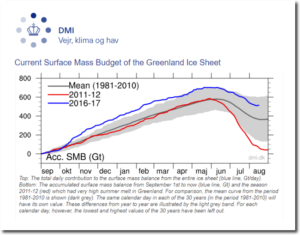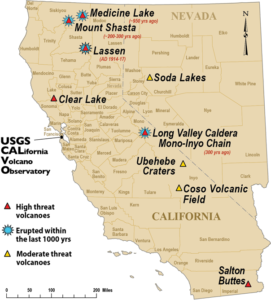by DOE/Sandia National Laboratories, August 21, 2017 in ScienceDaily
-
Scientists are working toward a better understand whether cyanobacteria can be grown for biofuels on a large scale.
See also here
by DOE/Sandia National Laboratories, August 21, 2017 in ScienceDaily
Scientists are working toward a better understand whether cyanobacteria can be grown for biofuels on a large scale.
See also here
by National Center for Atmospheric Research/University Corporation for Atmospheric Research, August 21, 2017 in ScienceDaily
Tremendous amounts of soot, lofted into the air from global wildfires following a massive asteroid strike 66 million years ago, would have plunged Earth into darkness for nearly two years, new research finds. This would have shut down photosynthesis, drastically cooled the planet, and contributed to the mass extinction that marked the end of the age of dinosaurs.
by Robin Mills, August 20, 207 UAE Ed The National
The Middle Eastern countries that are looking at coal are trying to diversify their fuel mix, and to reduce vulnerability to economic or supply shocks. Gas is cheap at the moment but its price is volatile, and states such as Dubai, Egypt and Turkey do not want to be too import-dependent. For Dubai, which attracted a very competitive bid from Acwa and Harbin, coal is a key part of strengthening its negotiating position with other suppliers. Iran and Turkey are trying to maximise the use of their domestic coal, and for Turkey, reliance on rivals Iran and Russia for two-thirds of its gas is dangerous.
Despite gas prices being low at the moment, coal is cheaper still — at least once the required import facilities are constructed. Chinese power and engineering companies, looking for other markets, are offering their expertise and low-cost financing.
by Nicolas Stiel, 21 août 2017, in Challenge
Total rachète le Danois Maersk Oil pour plus de 7 milliards de dollars, soit sa plus grosse acquisition depuis celle d’Elf Aquitaine en 2000. Grâce à elle, le pétrolier vise 3 millions de barils-jours en 2019.
See also OGJ
by Robert Rapier, August 15, 2017 in Forbes
That’s the peak oil argument in a nutshell, but the peak demand argument is entirely different. In this case, oil production falls — not because of geological factors — but because the world turns its back on oil as cleaner, cheaper options become available. Electric vehicles and ride-sharing on a massive scale are envisioned as two of the key factors that will make oil obsolete.
by Werner Brozek, August 20, 2017 in WUWT
In order to determine if records are possible in 2017, one must know the previous records as well as the average to date and what is required for the rest of the year in order for a particular data set to set a new record.
For the five data sets I cover, records were set in 2016. For now, I am not concerned about the statistical significance of the records, nor the number of decimal places. I merely want to know if the record can be beaten this year. At the end of the year, I plan on reporting any records and how statistically significant they are.
by Roy W. Spencer, Ph. D., August 19, 2017 in GlobalWarming
Al Gore has provided a target-rich environment of deceptions in his new movie.
After viewing Gore’s most recent movie, An Inconvenient Sequel: Truth to Power, and after reading the book version of the movie, I was more than a little astounded. The new movie and book are chock-full of bad science, bad policy, and factual errors.
by Tony Heller, August 20, 2017 in DeplorableClimSciBlog
This week in 1992, Hurricane Andrew hit Florida with 146 MPH winds. It was the last category 5 hurricane to hit the US.
by Paul Homewood, August 19, 2017
The climate industry likes to pretend that the Little Ice Age was just a local event in Europe, but studies like this one give the lie to that.
Interestingly this Tyson study also includes graphs of historical temperature trends in other parts of the world, for comparison. They all clearly show the MWP and Little Ice Age, although the peaks and troughs don’t always match.
See also here
by David Middleton, August 18, 2017 in WUWT
If “the supervolcano threat is substantially greater than the asteroid or comet threat,” does this mean we can stop fretting about Gorebal Warming and the Sixth Mass Extinction? Is NASA really moving on to actual threats to the planet? Well, not threats to the planet… The planet has handled supervolcanoes, asteroids and comets quite well over its 4.5 billion year lifespan.
by David Blackmon, August 17, 2017 in Forbes
“We should view the Permian Basin as a permanent resource,” he says, “The Permian is best viewed as a near infinite resource – we will never produce the last drop of economic oil from the Basin.”
No one disputes that the resource in the Permian is huge, but ‘infinite’ is a big word. I asked him to expand on that concept.
See also here
by Tony Heller, August 17, 2017 in TheDeplClimScienceBlog
Winter has arrived about 10 days early in the Arctic, and Greenland’s surface has gained 500 billion tons of ice – about 33% above normal.

by Indiana University, August 17, 2017 in ScienceDaily
“There are models that predict that the interior of the East Antarctic ice sheet wouldn’t change very much, even if the West Antarctic ice sheet was taken away,” Licht said. According to these models, even if the ice sheet’s perimeter retreats, its core remains stable.
by Dr. Ronan Connolly & Dr. Michael Connolly, August 16, 2017 in WUWT
Satellite observations indicate that the average Arctic sea ice extent has generally decreased since the start of the satellite records in October 1978. Is this period long enough to assess whether the current sea level trend is unusual, and to what extent the decline is caused by humans?
This change in Arctic climate is often promoted as evidence that humans are causing drastic climate change. For instance, an April 29th 2017 article in the Economist (“Skating on thin ice”, pg 16) implied that the Arctic is melting unusually, dramatically and worryingly (…)
by Jochen J. Brocks et al., August 2017, in Nature
The ‘Rise of Algae’ created food webs with more efficient nutrient and energy transfers, driving ecosystems towards larger and increasingly complex organisms. This effect is recorded by the concomitant appearance of biomarkers for sponges and predatory rhizarians, and the subsequent radiation of eumetazoans in the Ediacaran period.
See also here
by Kip Hansen, August 16, 2017
“Since there is no universally accepted definition for Earth’s average temperature, several different groups around the world use slightly different methods for tracking the global average over time, including:
NASA Goddard Institute for Space Studies
NOAA National Climatic Data Center
UK Met Office Hadley Centre”
by Tony Heller, August 16, 2017 in DeplorableClimSciBlog
NASA says 97% of scientists agree that their temperature graphs are accurate, and NASA, NOAA, CRU and JMA all independently agree very precisely about global temperature going back to 1880.
This is quite remarkable, considering that NASA doesn’t agree with their own data, having doubled 1880-2000 warming over the past 15 years.
by Paul Voosen, August 15, 2017
Scientists announced today that a core drilled in Antarctica has yielded 2.7-million-year-old ice, an astonishing find 1.7 million years older than the previous record-holder
(…)
If the new result holds up, says Yige Zhang, a paleoclimatologist at Texas A&M University in College Station, the proxies will need to be recalibrated. “We have some work to do.”
by Oregon State University, August 15, 2017 in ScienceDaily
A Triceratops or Tyrannosaurus rex bulling its way through a pine forest likely dislodged flowers that 100 million years later have been identified in their fossilized form as a new species of tree.
by Larry Kummer, August 15, 2017
While we obsess about climate change and debate if we live in the Anthropocene, we prepare poorly or not at all for natural forces like volcanoes that can level cities. This is folly we can no longer afford. Experts recommend a simple first step to better protect ourselves. Let’s start listening, or nature will teach us an expensive lesson.
California is the State most at risk due to its volcanoes near major cities, as shown in this map from the website of the California Volcano Observatory

by P Gosselin, August 15, 2017 in ClimateChangeDispatch
Here’s a good example of how climate alarmists and leftists in Germany react when confronted with different opinions or the truth. It just illustrates the brand of radicalism we’re up against.
by Kenneth Richard, August 14, 2017 in NoTricksZone
by Blair King, April 10, 2016
Specifically the Bureau of Land Management Health Risk Evaluation for Cabon Dioxyde points out:
A value of 40,000 ppm is considered immediately dangerous to life and health based on the fact that a 30-minute exposure to 50,000 ppm produces intoxication, and concentrations greater than that (7-10%) produce unconsciousness (NIOSH 1996; Tox. Review 2005). Additionally, acute toxicity data show the lethal concentration low (LCLo) for CO2 is 90,000 ppm (9%) over 5 minutes (NIOSH 1996).
See also The Lake Nyos Disaster
See also here
by Paul Matthews, August 13, 2017 in CimateScepticism
In many ways, the climate debate has hardly changed since I got interested in it about ten years ago. Public opinion wobbles up and down with hardly any real change. The same tired arguments and claims come round again: every climate conference is the last chance to save the planet; the Arctic ice is always about to vanish in one or two years, or ten years; climate scientists continue to be accused of selecting data sets to create hockeysticks and manipulating data; and teams of climate scientists keep producing reports saying almost exactly the same thing as the previous reports, which then get misrepresented and hyped by the media.
by Robin McKie, August 12, 2017 The Guardian
The Edinburgh volcano survey, reported in the Geological Society’s special publications series, involved studying the underside of the west Antarctica ice sheet for hidden peaks of basalt rock similar to those produced by the region’s other volcanoes. Their tips actually lie above the ice and have been spotted by polar explorers over the past century.
Des scientifiques découvrent 91 nouveaux volcans sous les glaciers de l’Antarctique